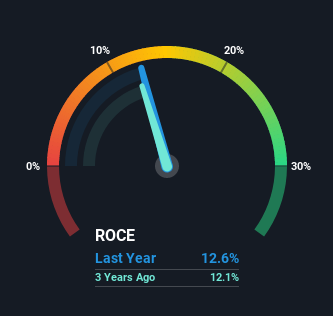- Malaysia
- /
- Construction
- /
- KLSE:HOHUP
Capital Allocation Trends At Ho Hup Construction Company Berhad (KLSE:HOHUP) Aren't Ideal

Finding a business that has the potential to grow substantially is not easy, but it is possible if we look at a few key financial metrics. Amongst other things, we'll want to see two things; firstly, a growing return on capital employed (ROCE) and secondly, an expansion in the company's amount of capital employed. If you see this, it typically means it's a company with a great business model and plenty of profitable reinvestment opportunities. Although, when we looked at Ho Hup Construction Company Berhad (KLSE:HOHUP), it didn't seem to tick all of these boxes.
Return On Capital Employed (ROCE): What is it?
For those who don't know, ROCE is a measure of a company's yearly pre-tax profit (its return), relative to the capital employed in the business. Analysts use this formula to calculate it for Ho Hup Construction Company Berhad:
Return on Capital Employed = Earnings Before Interest and Tax (EBIT) ÷ (Total Assets - Current Liabilities)
0.13 = RM107m ÷ (RM1.5b - RM622m) (Based on the trailing twelve months to June 2021).
So, Ho Hup Construction Company Berhad has an ROCE of 13%. In absolute terms, that's a satisfactory return, but compared to the Construction industry average of 5.5% it's much better.
View our latest analysis for Ho Hup Construction Company Berhad

While the past is not representative of the future, it can be helpful to know how a company has performed historically, which is why we have this chart above. If you'd like to look at how Ho Hup Construction Company Berhad has performed in the past in other metrics, you can view this free graph of past earnings, revenue and cash flow.
So How Is Ho Hup Construction Company Berhad's ROCE Trending?
In terms of Ho Hup Construction Company Berhad's historical ROCE movements, the trend isn't fantastic. Over the last five years, returns on capital have decreased to 13% from 28% five years ago. Given the business is employing more capital while revenue has slipped, this is a bit concerning. This could mean that the business is losing its competitive advantage or market share, because while more money is being put into ventures, it's actually producing a lower return - "less bang for their buck" per se.
On a side note, Ho Hup Construction Company Berhad's current liabilities are still rather high at 42% of total assets. This can bring about some risks because the company is basically operating with a rather large reliance on its suppliers or other sorts of short-term creditors. Ideally we'd like to see this reduce as that would mean fewer obligations bearing risks.
Our Take On Ho Hup Construction Company Berhad's ROCE
In summary, we're somewhat concerned by Ho Hup Construction Company Berhad's diminishing returns on increasing amounts of capital. Long term shareholders who've owned the stock over the last five years have experienced a 57% depreciation in their investment, so it appears the market might not like these trends either. Unless there is a shift to a more positive trajectory in these metrics, we would look elsewhere.
Since virtually every company faces some risks, it's worth knowing what they are, and we've spotted 7 warning signs for Ho Hup Construction Company Berhad (of which 3 are a bit unpleasant!) that you should know about.
While Ho Hup Construction Company Berhad isn't earning the highest return, check out this free list of companies that are earning high returns on equity with solid balance sheets.
Valuation is complex, but we're here to simplify it.
Discover if Ho Hup Construction Company Berhad might be undervalued or overvalued with our detailed analysis, featuring fair value estimates, potential risks, dividends, insider trades, and its financial condition.
Access Free AnalysisThis article by Simply Wall St is general in nature. We provide commentary based on historical data and analyst forecasts only using an unbiased methodology and our articles are not intended to be financial advice. It does not constitute a recommendation to buy or sell any stock, and does not take account of your objectives, or your financial situation. We aim to bring you long-term focused analysis driven by fundamental data. Note that our analysis may not factor in the latest price-sensitive company announcements or qualitative material. Simply Wall St has no position in any stocks mentioned.
Have feedback on this article? Concerned about the content? Get in touch with us directly. Alternatively, email editorial-team (at) simplywallst.com.
About KLSE:HOHUP
Ho Hup Construction Company Berhad
An investment holding company, engages in foundation and civil engineering, and building contracting works in Malaysia.
Good value slight.
Similar Companies
Market Insights
Community Narratives



